oil change AUDI S6 2012 Owners Manual
[x] Cancel search | Manufacturer: AUDI, Model Year: 2012, Model line: S6, Model: AUDI S6 2012Pages: 298, PDF Size: 74.43 MB
Page 23 of 298
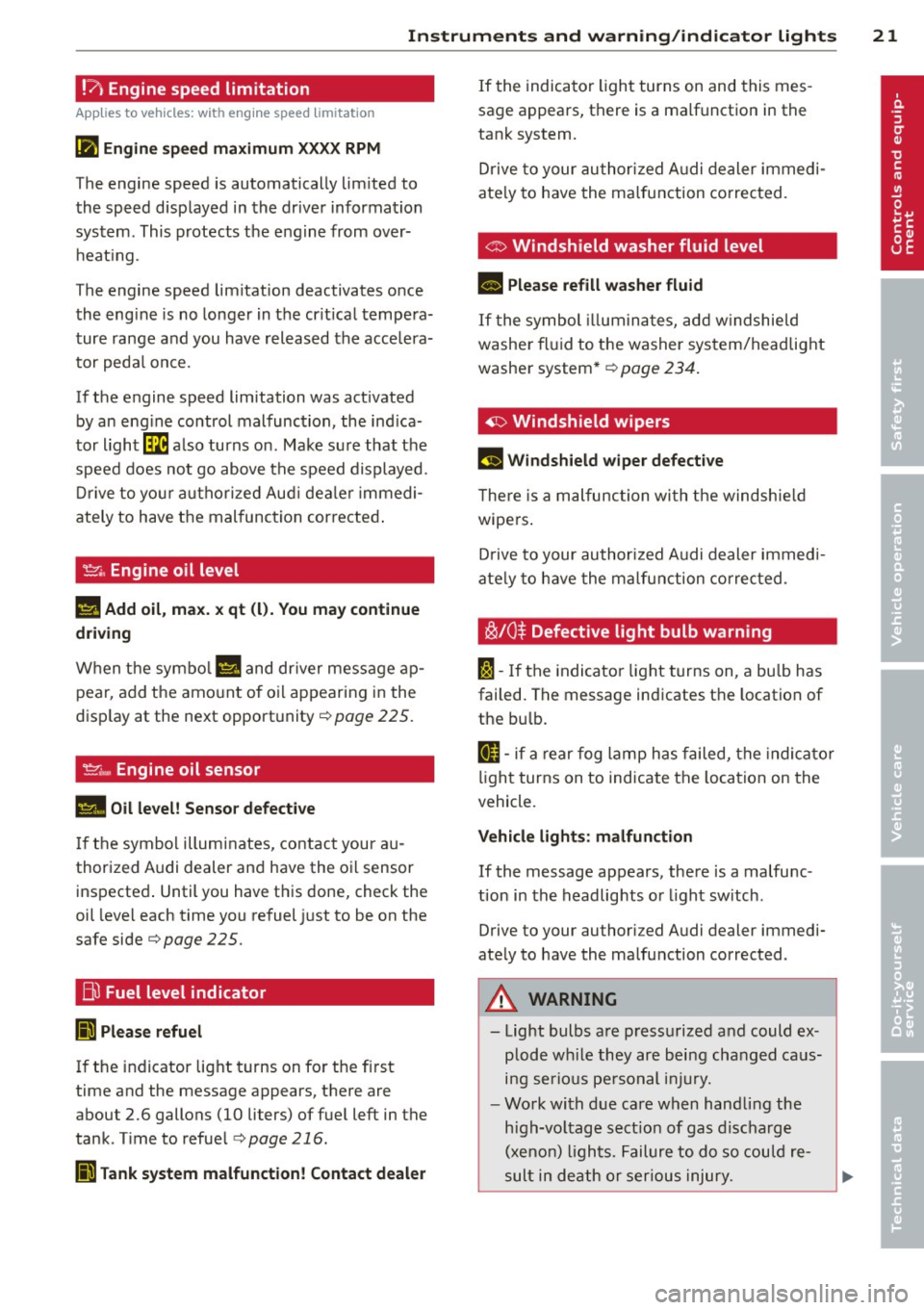
Instruments and warning/indicator lights 21
!?i Engine speed limitation
A ppl ies to vehicles: wit h en gin e s pee d l im itat ion
(II Engine speed maximum XXXX RPM
The engine speed is automatically limited to
the speed displayed in the driver information
system. This protects the engine from over heating.
The engine speed limitation deactivates once
the engine is no longer in the critical tempera
ture range and you have released the accelera
tor pedal once.
If the engine speed limitation was activated by an engine control malfunction, the indica
tor light~ also turns on. Make sure that the
speed does not go above the speed displayed.
Drive to your authorized Audi dealer immedi
ately to have the malfunction corrected.
~ . Engine oil level
II Add oil, max. x qt (l). You may continue
driving
When the symbol Ill and driver message ap
pear, add the amount of oil appearing in the
display at the next opportunity ¢
page 225.
~ .... Engine oil sensor
II Oil level! Sensor defective
If the symbol illuminates, contact your au
thorized Audi dealer and have the oil sensor inspected. Until you have this done, check the
oil level each time you refuel just to be on the
safe side¢
page 225.
Bil Fuel level indicator
Ii Please refuel
If the indicator light turns on for the first
time and the message appears, there are
about 2.6 gallons (10 liters) of fuel left in the
tank . Time to refuel
¢ page 216.
Ii Tank system malfunction! Contact dealer
If the indicator light turns on and this mes
sage appears, there is a malfunction in the
tank system.
Drive to your authorized Audi dealer immedi
ately to have the malfunction corrected.
C> Windshield washer fluid level
II Please refill washer fluid
If the symbol illuminates, add windshield
washer fluid to the washer system/headlight
washer system* ¢
page 234.
~ Windshield wipers
rlJ Windshield wiper defective
There is a malfunction with the windshield
wipers.
Drive to your authorized Audi dealer immedi
ately to have the malfunction corrected.
~/0$ Defective light bulb warning
f'a-If the indicator light turns on, a bulb has
failed. The message indicates the location of
the bulb.
IJ-if a rear fog lamp has failed, the indicator
light turns on to indicate the location on the
vehicle.
Vehicle lights: malfunction
If the message appears, there is a malfunc
tion in the headlights or light switch .
Drive to your authorized Audi dealer immedi
ately to have the malfunction corrected.
A WARNING
- Light bulbs are pressurized and could ex
plode while they are being changed caus
ing serious personal injury.
- Work with due care when handling the
high-voltage section of gas discharge
(xenon) lights. Failure to do so could re
sult in death or serious injury.
Page 28 of 298
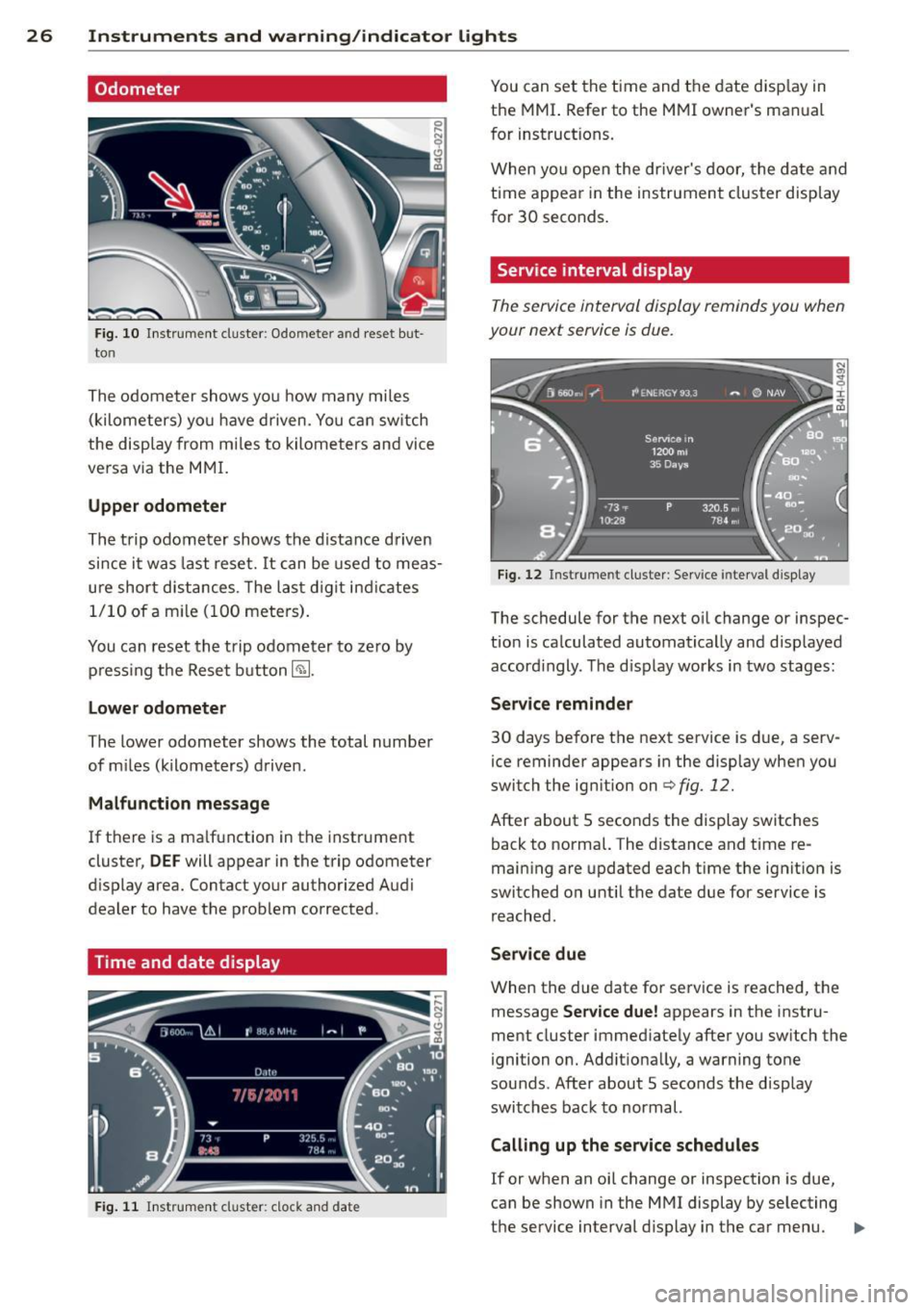
26 Instruments and warning /indicator lights
Odometer
Fig . 10 In str ument cl uster: Odomete r an d reset but
ton
The odometer shows yo u how many mile s
(kilome ters) yo u have driven. You c an switch
the disp lay from mi les to kilome ters and vice
ve rsa via the M MI.
Upper odometer
Th e trip odom eter shows the d istance d riven
si nce i t was last rese t.
It can be used to meas
u re shor t distances. The l ast d igit in di cates
1/1 0 of a m ile ( 100 mete rs) .
You can reset th e trip o dom eter to ze ro by
p re ss ing the Reset button~-
Lower odometer
The lower odometer shows the total numbe r
of m iles (k ilometers) d rive n.
Malfunction message
If t here is a ma lfunction in the instrument
cluster ,
DEF will appear in the trip odometer
d isplay area. Contact your authorized Audi
deale r to have the p roblem corrected.
Time and date display
F ig. 11 I n str ume nt cluster : cloc k an d date
You can set the time and t he date disp lay in
the MMI. Refer to the M MI owne r's manual
f or instructions.
When yo u open the driver's door, the date and
time appea r in the inst rument cluster disp lay
for 30 seconds .
Service interval display
The service interval display reminds you when
your next service is due.
Fig . 12 Instrume nt c lu ste r: Se rvice inte rval disp lay
The schedule for the next o il change or inspec
tion is ca lculated automatically and disp layed
accord ingly . Th e d isp lay works in two stages:
Service reminder
30 days be fore the next service is d ue, a serv
ice reminder appears in the display when you
switch the ign ition on
¢ fig. 12.
After about 5 seconds the display switches
back to norma l. The distance and time re
mai ning are updated each t ime the ignit io n is
switched on until the date due for service is
r eached.
Service due
When the due date for se rvice is reached, the
message
Service due! appears in the instru
ment cluster immed iate ly after yo u sw itch the
ignition o n. Add it iona lly, a warning tone
sounds . After about 5 seconds the disp lay
switches bac k to normal.
Calling up the service schedules
If or when an oil change or inspection is due,
can be shown in the MMI display by selecting
t h e service interval d isplay in the car menu.
II>
Page 29 of 298
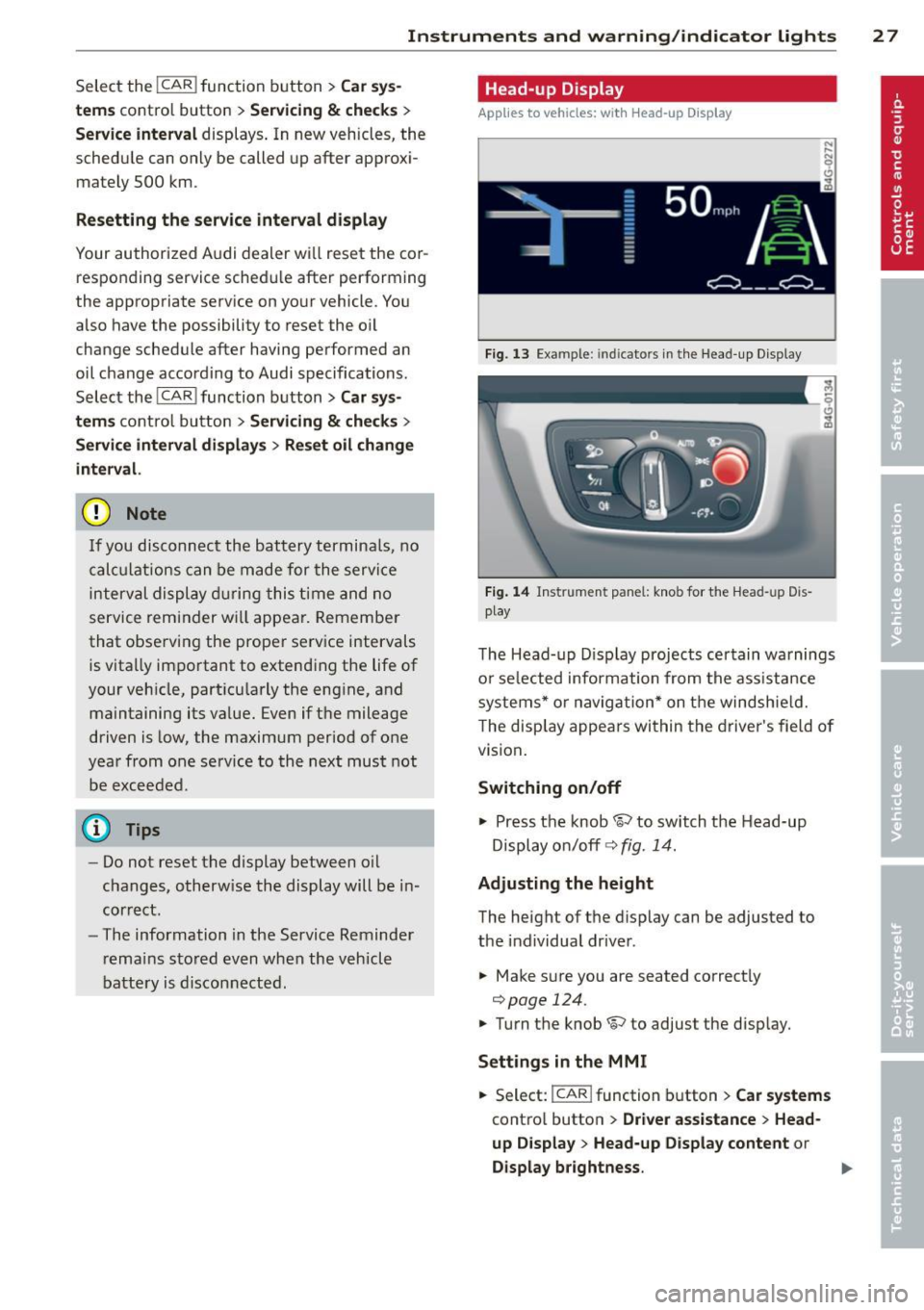
Instrument s and warning /indicator lights 2 7
Select the I CAR I func tion button > Car sy s
tems
co ntrol button > Servicing & check s >
Service inte rval displays . In new vehicles, the
schedu le can only be called up after approx i
mate ly S00 km.
Resetting the ser vice interval d isplay
Your authorized A udi dealer wi ll rese t the cor
respo nding service schedule after performing
the appropriate service on yo ur vehicle. You
also have the possibility to reset the oil
change schedule after having performed an
oil change accord ing to Audi specifications.
Select the
I CAR ! function b utton > Car sys
tem s
control button > Servicing & checks >
Servic e int erval display s> Reset oil change
interval.
(D Note
If you disconnect the bat tery t ermina ls, no
calc ulatio ns can be made for the servi ce
interv al displ ay d uring this time and no
service remi nder w ill appear. Remembe r
that obse rving the prope r se rv ice intervals
is vita lly impo rtant to extend ing the life of
y o ur veh icle, part icu larly the eng ine, and
maintaining its va lue . Even if th e mileage
driven is low, the maximum period of one
yea r from one se rvice to the next must not
be excee ded.
@ Tips
- Do not reset t he display between o il
changes, o therw ise the display will be i n
cor re ct.
- The informati on in the Service Reminder
r ema ins sto red even when the vehicle
batte ry is disco nnecte d.
Head-up Display
Applies to vehicles: with Head-up Disp lay
Fi g. 13 Exampl e: indica tors in th e Head -up D isp lay
Fi g. 14 In strument pa nel: k nob for the Head-up Dis
play
T he Head- up D isplay projects certain warnings
o r se le cted information from the ass istance
systems* o r naviga tion * on t he windshie ld.
T he disp lay appea rs within t he dr ive r's fie ld o f
vision .
Switching on/off
1-Press t he knob~ to switch the Head-up
Displ ay on/off ¢
fig. 1 4.
Adjusting the height
The height of the dis p lay can be adjusted to
the individual drive r.
.. Make s ure you are seated correctly
¢page
124 .
.. Turn the knob~ to adjust the display.
Settings in the MMI
.. Se lect: I CAR I function button > Car systems
cont ro l butto n > Driver assistance > Head·
up D isplay
> Head -up Display content or
Display br ightness . ..,.
Page 90 of 298
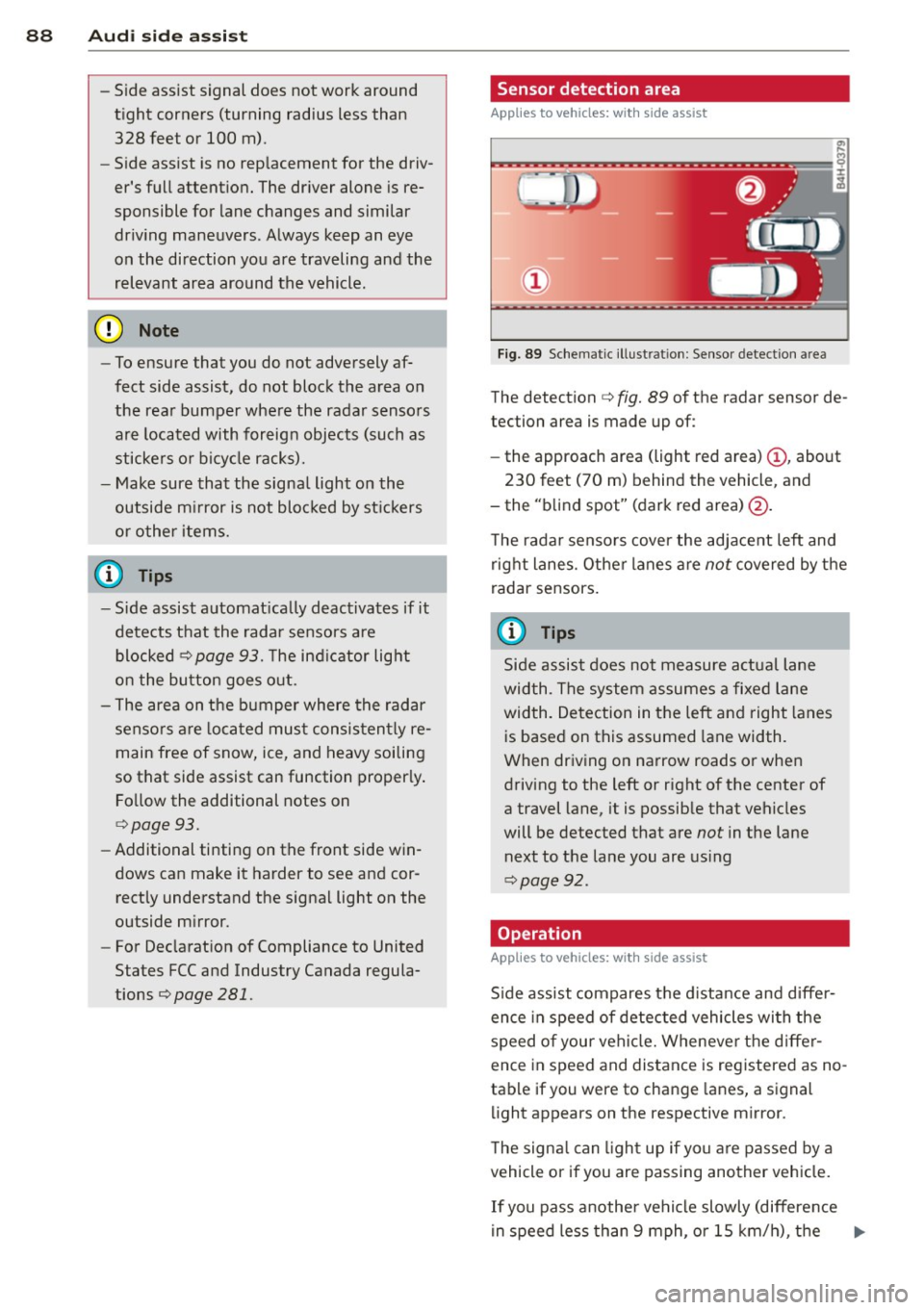
88 Audi side a ssis t
- Side assist signal does not work around
t ight corners (turning radius less than
328 feet or 100 m).
- Side assist is no rep lacement for the driv
er's full attent ion. The dr iver alone is re
sponsible for lane changes and similar dr iv ing maneuvers . Always keep an eye
on the di rection yo u are traveling and the
relevant area around the vehicle.
(D Note
- To ensure that you do not adversely af
fect side assist, do not block the area on
the rear bumper whe re the radar sensors
are located with foreign objects (such as
stickers o r bicy cle racks).
- Make sure that the signa l light on the
outside m irror is not blo cked by st ickers
or other items.
@ Tips
- Side assist a utomat ica lly deactivates if it
detects that the radar sensors a re
blocked E} page 93. The ind icator light
on the bu tton goes out.
- The area on the bumper where the radar
sensors are located must consis tently re
main free of snow, ice, and heavy soiling
so that side assist can function properly .
Fo llow the additional notes on
c> page 93.
-Additional tinting on the front side win
dows can make it harder to see and cor
rectly understand the signa l light on the
outside mirror.
- For Declarat ion of Compliance to United
States FCC and Industry Canada regula
tions
c> page 281.
Sensor detection area
Applies to veh icles: w ith side assist
F ig. 89 Schemat ic ill ust rat ion : Sensor detect ion a rea
The detection c> fig. 89 of the radar sensor de
tection area is made up of:
- the approach area (light red area)
(D , about
230 feet (70 m) behind the vehicle, and
- the "b lind spot" (dark red area)@.
T he rada r sensors cover the adjace nt left and
right lanes. Other lanes a re
not covered by the
radar sensors.
(0 Tips
Side assist does not measure a ctual lane
wid th. The system assumes a fixe d lane
width. Detection in the left and right lanes
is based on this assumed lane width .
When driv ing on narrow roads or when
driving to the left or right of the center of
a travel lane, it is possible that vehicles
will be detected that are
not in the lane
next to the lane you are us ing
c> page 92.
Operation
Applies to veh icles: w ith s ide assist
S ide assist compares t he d istance and diffe r
ence in speed of detected vehicles wi th the
speed of your vehi cle. Wheneve r the d iffe r
ence in speed and distance is registered as no
tab le if you were to change lanes, a signal
li ght appears on the respective mirror.
T he signa l can ligh t up if yo u are passed by a
vehicle or if you are passing another vehicle.
If you pass another vehi cle slowly (difference
in speed less than 9 mph, o r 15 km/h), the ..,.
Page 213 of 298

grease or dye must be patted off using ab
sorbent materia l. It may be necessary to re
treat the areas with detergent paste a nd wa
ter.
I n the case of genera l soiling of the uphols
tery and cover material, we recommend hiring
a specialist that has the equ ipment to clean
the seat covers and other fabric surfaces by
shampooing and spray extraction.
A WARNING
Always read and heed all WARNINGS and
the information
Q page 204.
Open Velcro fasteners on your clothing can
damage the seat cover. Please make sure
that Velcro fasteners are closed.
Plastic parts and instrument panel
Always use a clean cloth moistened in clear
water to clean these areas. For pers istent dirt
use an Audi approved
s olvent -fr ee plasti c
cleane r/pro te cta nt.
A WARNING
So lvents can change the properties o f
some plastics and make it ha rder for the
airbag to dep loy.
- Never clean the instr ument pane l o r the
s u rface of airbag modules with cleaning
products that contain solvents.
- Products containing solvents w ill make
the surface o f th is part porous.
- Serious injuries can result if plastic pa rts
come loose whe n the airbag is deployed .
- Always read and heed all WARN INGS and
ot her information~
page 204 .
(D Note
Cleaning agents containing solvents will
a tt ack t he mater ial and ca n change the
way i t behaves .
Cleaning and protec tion 21 1
Trim and molding
Trim and molding in the vehicle inte rior can
be clean ed wi th a dry m icrofiber cloth. To pre
vent scratches, do not use any cleaning so lu
tions.
Natural leather
Appl ies to vehicles: with natural leather
Audi makes great efforts to maintain the
properties, natural look and feel of interior
leather .
General
We offe r ma ny d iffe rent types of leathe r o n
ou r vehicles. Most are diffe rent types of nappa
l eather, which has a smooth surface and
comes in various colo rs .
T he intensity of the co lor determ ines the visu
al cha racteristics and appea ran ce. If the su r
f a ce of the leather has a typ ica l na tural look,
then the leather is a nap pa lea ther that has
been left in a relative ly natura l condition . This
leather offers particularly good comfort and
breathes well. Fine veins, closed grains, insect
bites, sk in fo lds, and subt le variations in color
rema in v isible. These character istics demon
strate that the mate rial is natural.
Natura l nappa leather is not covered by a co l
or finish. It is therefore more sens it ive to soil
ing and wear, which is someth ing you need to
conside r if ch ildren, animals or other factors
might prove to be part icu larly hard o n the
leat her .
By contrast, leather types that are covered by
a colo red finish layer are more durable. This
has a positive effect on the leather 's resist
an ce to wea r and soiling in da ily use. On the
othe r hand, the typica l charac teristics of natu
ral leathe r are barely or not appa ren t. Howev
er, this does not mean that the leathe r itse lf
is of infe rior quality. •
•
Page 225 of 298
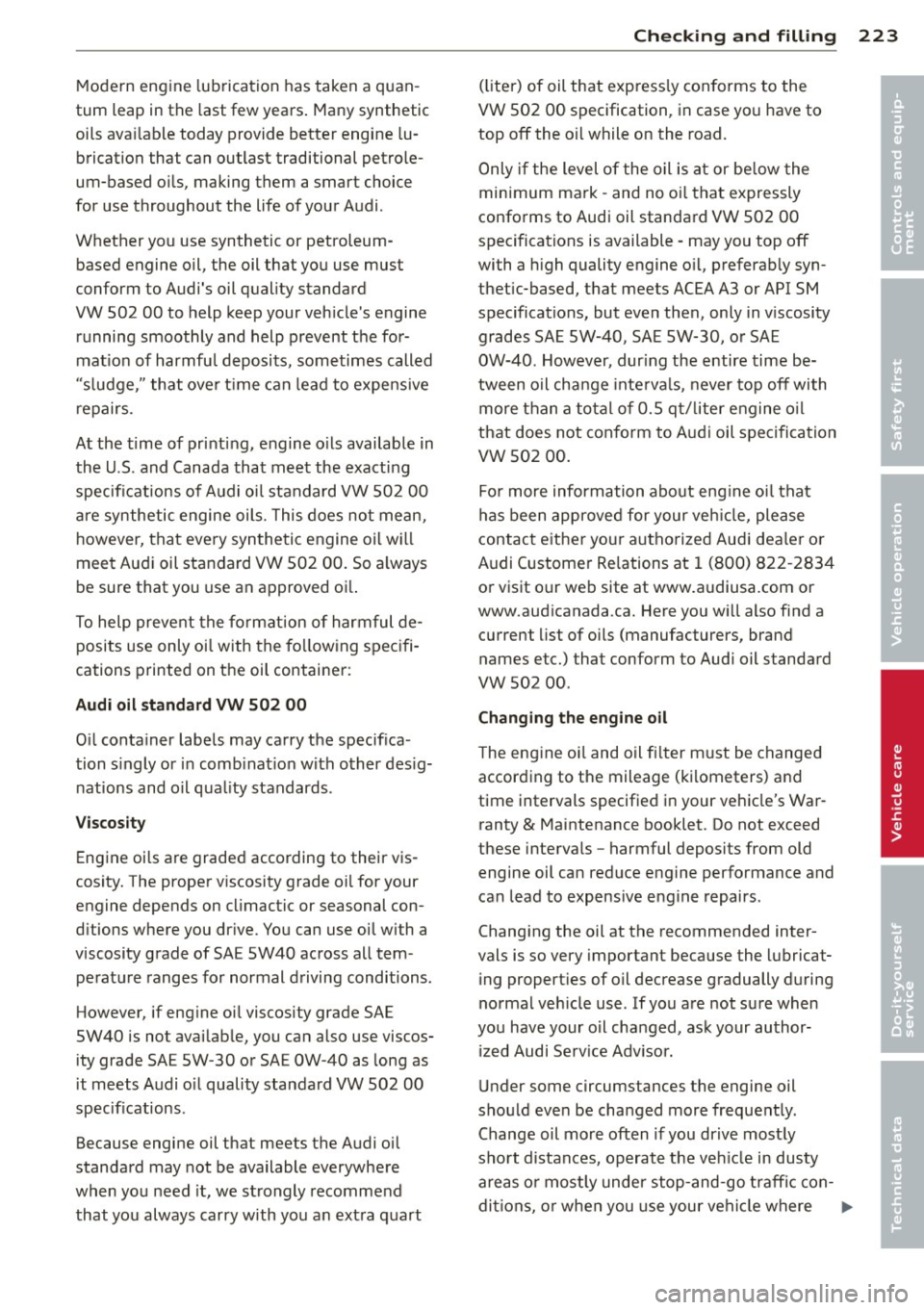
Modern eng ine lubrication has taken a quan
tum leap in the last few years . Many synt hetic
oils ava ilable today provide better engine lu
brication that can ou tlast traditional petrole
um-based o ils, making them a smart choice
for use throughout the life of your Audi .
Whether you use synthetic or petroleum based engine oil, the oil that you use must
conform to Audi's oil quality standard
VW 502 00 to help keep your veh icle 's engine
running smoothly and help prevent the for
mat ion of harmfu l deposits, sometimes called
"s ludge," that ove r time can lead to expensive
r epairs .
At the t ime of pri nting , engine o ils available in
the U .S . and Canada that meet the exacting
specifications of Audi oi l standard VW 502 00
are synthetic engine oils. This does not mean, h owever, that every syn thetic engine oil w ill
meet Audi oil standard VW 502 00. So a lways
be sure that you use an approved oi l.
To help preve nt the format ion of harmful de
posits use only oi l with the fo llow ing spec ifi
cations printed on the oil container :
Audi oil standard VW 502 00
O il conta iner labels may carry the specif ica
tion s ingly or in comb inat ion w ith other des ig
nations and oil qua lity standards .
Viscosity
Engine oi ls are graded according to their vis
cosity. The proper v iscosity grade oi l for your
engine depends on cl imactic or seasonal con
d itions where you dr ive. You can use oil with a
viscosity grade of SA E 5W40 across all tem
pe rature ranges for normal d riving conditions .
However, if eng ine oi l viscosity grade SA E
5W40 is not avai lab le, you can also use viscos
ity grade SAE 5W -30 or SA E OW-40 as long as
it meets Audi o il quality standard VW 502 00
specifications .
Because engine oil that meets the A udi oil
standard may not be available everywhere
when you need it, we s trongly recomme nd
that you always carry with you a n ext ra quart
Checkin g and fillin g 223
(li ter) of oil that exp ress ly con forms to the
VW S02 00 specification , in case you have to
top
off the o il while on the road.
Only if the level of the o il is at or be low the
minimum mark -and no oi l that expressly
confo rms to Audi oil standard VW 502 00
spec ifications is available -may you top
off
with a h igh quality engine o il, prefe rab ly syn
thet ic-based, that meets ACEA A3 or API SM
spec ifications, but even then, only in v iscosity
grades SAE 5W-40 , SA E 5W-30, o r SAE
OW- 40 . However, dur ing the entire time be
tween o il cha nge inte rva ls, never top
off with
more than a tota l of 0. 5 q t/liter engine o il
that does not con form to A udi oil spe cification
VW S02 00.
Fo r more information abo ut eng ine oi l tha t
has been approved for your veh icle, ple ase
contac t eit h er yo ur autho rized Aud i dea le r or
Audi C ustomer Re lations at 1 (800) 822 -2834
or visit our web site at www .a u diusa.com or
www.aud icanada .ca. Here you w ill also find a
current list of oils (manufacturers, brand
names e tc.) tha t conform to Audi oil s tandard
vw 502 00.
Changing the engine oil
T he eng ine oi l and o il f ilt er m ust be changed
according to the mileage (ki lometers) and
time intervals specified i n your ve hicle's War
ranty
& Maintenance booklet. Do not exceed
these interva ls - harmful deposits from old
engine oil can reduce engine performance and
can lead to expensive engine repairs.
Changi ng the oil at the recommended inter
vals is so very important beca use the l ubricat
ing propert ies of oil decrease gradually during
norma l veh icle use . If you a re not sure when
yo u have your o il cha nged, ask your author
ized Audi Se rv ice Adv isor.
Under some circumstances the engine oil
shou ld eve n be changed more frequent ly .
Change oil more often if you dr ive most ly
sho rt distances, operat e the ve hicle in dusty
areas o r most ly under stop-and -go traff ic con-
di tions, o r when you use your vehi cle where .,..
•
•
Page 226 of 298
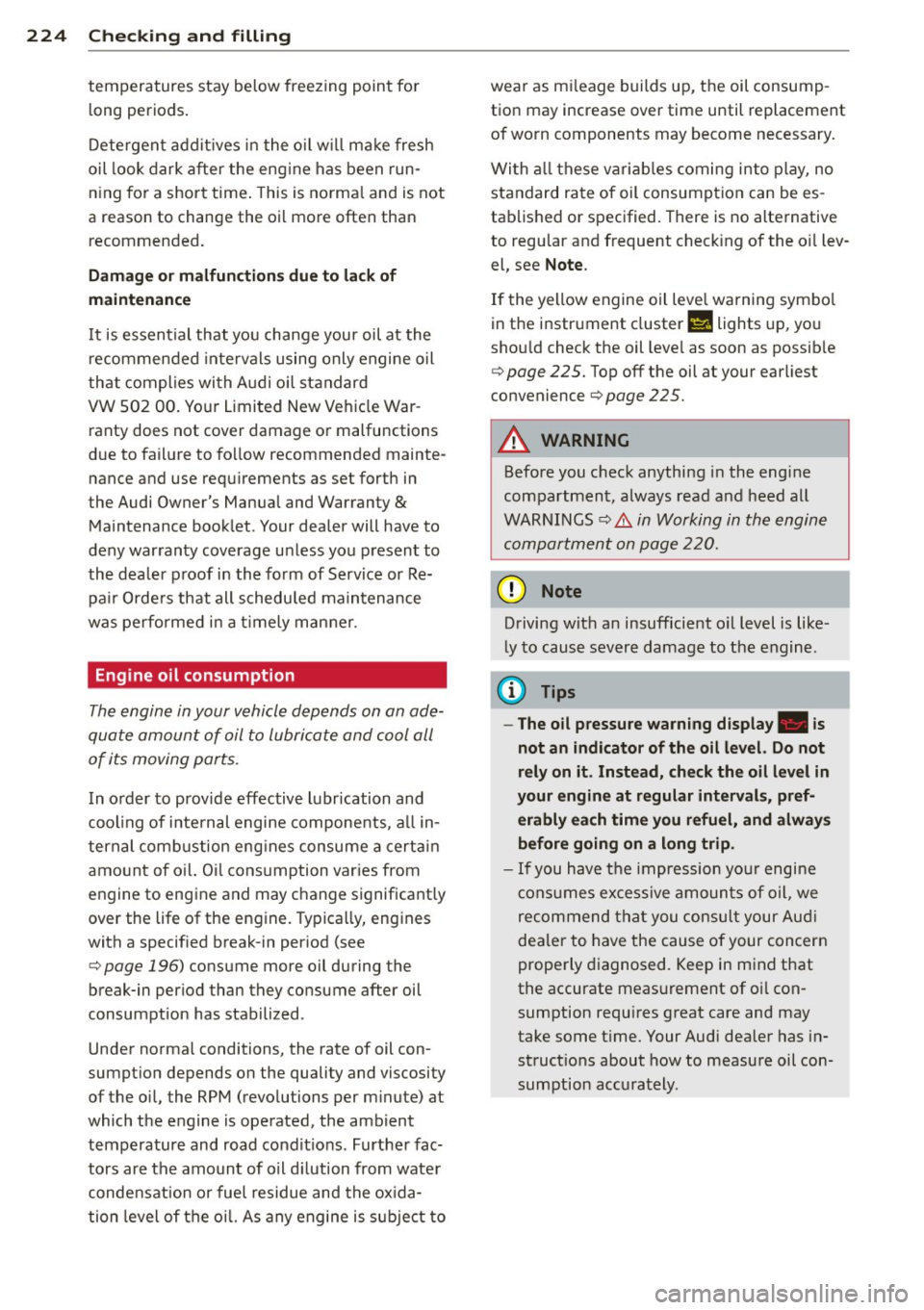
224 Check ing and filling
temperatures stay below freezing point for
long periods.
Detergent add it ives in the o il w il l make fresh
oil look dark after the eng ine has been run
ning for a short time . This is norma l and is not
a reason to change the oi l more often than
recommended.
D am age or m alfunc tions du e to lack of
m ainten ance
It is essential that you change your oil at the recommended in tervals using only engine o il
that complies with Audi oi l standard
VW 502 00. You r Limited New Vehicle War
ranty does not cover damage or malfunctions
due to fail ure to fo llow recommended mainte
nance and use requ irements as set forth in
the Audi Owner's Manual and Warranty &
Maintenance book let . Your dealer will have to
deny warranty coverage unless you present to
the dea ler proof in the form of Service or Re
pa ir Orders that all scheduled ma intenance
was performed in a t imely manner.
Eng ine oil consumption
The engine in your vehicle depends on an ade
quate amount of oil to lubricate and cool all
of its moving parts.
In order to provide effective lubrication and
cool ing of internal engine components, a ll in
ternal comb ustion eng ines consume a certa in
amount of oil. O il consumption varies from
engine to engine and may change significantly
over the life of the engine. Typica lly, engines
with a specif ied break-in period (see
¢
page 196) consume more oil during the
break-in period than they consume after oil
consumption has stabilized.
Under norma l conditions, the rate of oil con
sumpt ion depends on the quality and viscosity
of the oil, the RPM (revolutions per m inute) at
which the engine is operated, the ambient
temperature and road condit ions . Further fac
tors are the amount of oil d ilution from water
condensat ion or fuel residue and the ox ida
tion level of the oi l. As any engine is subject to wear as mi
leage builds up, the oil consump
tion may increase over time until replacement of worn components may become necessary.
With a ll these variab les coming into play, no
standard rate of oil consumption can be es
tablished or specified. There is no alternative
to regu lar and frequent check ing of the o il lev
el, see Note.
If the yellow engine oil leve l warning symbo l
in the instrument cluster
II! lights up, you
shou ld check the oil leve l as soon as possib le
¢
page 225. Top off the oil at your earliest
convenience
¢ page 225.
A WARNING '"---
Before you check anythi ng in the engine
compartment, always read and heed all
WARNINGS¢
A in Working in the engine
compartment on page 220.
(D Note
Driving w ith an insufficient o il level is like
ly to cause severe damage to the engine .
(D Tips
-The oil pressu re warn ing display. is
not an indic ator of the oil le vel. Do not
r el y on it . In ste ad, ch eck the oil lev el in
y our engin e at r eg ular inter vals , pref
erably ea ch time you r efu el, and alwa ys
before going on a long trip .
- If you have t he impression yo ur engine
cons umes ex cessive amoun ts of o il, we
recommend that you consu lt your Aud i
dea ler to have the cause of your concern
properly diagnosed. Keep in mind that
the accurate meas urement of oi l con
sumption requ ires great care and may
take some t ime. Your Audi dea ler has in
structions about how to measure oil con
sumption accurately.
-
Page 228 of 298

226 Check ing and filling
and ad versely a ffect yo ur New Vehicl e
W arr ant y.
@) For the sake of the environment
- Under no circumstances can the oil come
in contact with the sewage network o r
the soil.
- Observe and follow lega l regu lations
when disposing of empty oil containers .
Changing the engine oil
We recommend that have your oil changed by
an authorized Audi dealer or a qualified serv
ice station.
Before you check anything in the engine com
partment,
a lw ays rea d an d h eed all WARN
INGS c::> .& in Working in the engine compart
ment on page 220.
The engine oil must be changed accord ing to
the intervals specified in your Warranty
&
Maintenance book let. This is very important
because the lubricating properties of oil di
minish gradua lly during normal vehicle use .
Under some ci rcumstances the engine oi l
should be changed more frequently. Change
oil more often if you drive most ly short dis
tances, operate the vehicle in dusty areas or under predominantly stop-and-go traffic con
ditions, or have your vehicle where tempera
tures remain below freezing for extended pe
riods .
Detergent addit ives in the oil w ill make fresh
oil look dark after the engine has been run n ing for a short time. This is normal and is not
a reason to change the oil more often than recommended.
Because of the problem of proper disposal,
along w ith the special tools and necessary ex
pertise required , we strongly recommend that
you have your o il changed by an authorized
Audi de ale r or a qual ified servi ce station.
If y ou choo se to c hang e y our oi l y our self,
please note the followi ng important informa
tion :
A WARNING
To reduce the risk of personal injury if you
must change the eng ine oil in your vehicle
yourself:
- Wear eye protect ion.
- To reduce the risk of burns from hot en- gine oil, let the engine cool down to the
touch.
- When removing the o il dra in plug with
your fingers, stay as far away as possible.
Always keep your forearm parallel to the
ground to help prevent hot oil from runn ing down you r arm.
- Dra in the oil into a container designed
for this purpose, one large enough to
hold at least the total amount of oil in
your engine.
- Engine oil is poisonous. Keep it we ll out
of the rea ch of childre n.
- Continuous contact with used eng ine o il
is harmfu l to your sk in. Always protect
your skin by washing oil off tho roughly
with soap and wate r.
@ Note
Never mix oil additives with your engine
oi l. These additives can damage your en
g ine and adversely affect you r A ud i Limit
ed New Veh icle War ranty.
@ For the sake of the environment
- Before changing your oil, first make su re
you know where you can prope rly dispose
o f the used oil.
- Always dispose of used eng ine oi l proper
ly. Do not dump it on garden soil, wood
ed areas, into open streams or down
sewage drains.
- Recycle used engi ne oil by taking it to a
used engine oil collection facility in you r
area, or contact a service station.
Page 229 of 298
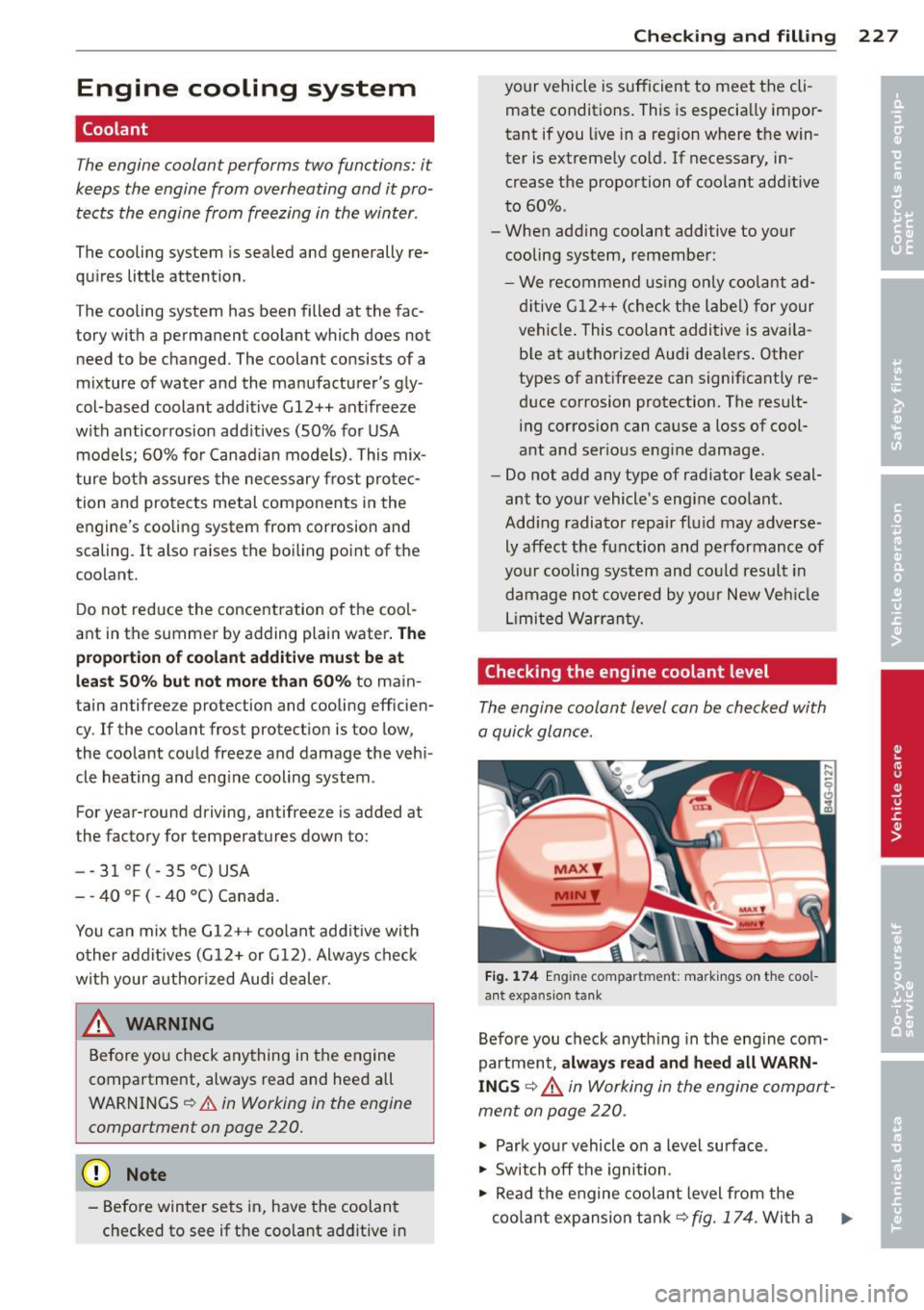
Engine cooling system
Coolant
The engine coolant performs two functions: it
keeps the engine from overheating and it pro
tects the engine from freezing in the winter .
The cooling system is sealed and generally re
quires little attention .
The cooling system has been filled at the fac
tory with a permanent coolant which does not
need to be changed. The coolant consists of a
mixture of water and the manufacturer's gly
col-based coolant additive G12++ antifreeze
with anticorrosion additives (50% for USA
models; 60% for Canadian models). This mix
ture both assures the necessary frost protec
tion and protects metal components in the
engine's cooling system from corrosion and
scaling. It also raises the boiling point of the
coolant.
Do not reduce the concentration of the cool
ant in the summer by adding plain water.
The
proportion of coolant additive must be at
least 50% but not more than 60%
to main
tain antifree ze protection and cooling efficien
cy. If the coolant frost protection is too low,
the coolant could freeze and damage the vehi
cle heating and engine cooling system.
For year-round driving, antifreeze is added at
the factory for temperatures down to:
- -31 °F ( -3 5 °C) USA
- -40 °F ( - 40 °C) Canada.
You can mix the G12 ++ coolant additive with
other additives (G12+ or G12). Always check
with your authorized Audi dealer.
& WARNING
Before you check anything in the engine
compartment, always read and heed all
WARNINGS
~ .&. in Working in the engine
compartment on page 220.
(D Note
- Before winter sets in, have the coolant
checked to see if the coolant additive in
Checking and filling 22 7
your vehicle is sufficient to meet the cli
mate conditions. This is especially impor
tant if you live in a region where the win
ter is extremely cold. If necessary, in
crease the proportion of coolant additive
to 60% .
- When adding coolant additive to your
cooling system, remember :
- We recommend using only coolant ad
ditive G12++ (check the label) for your
vehicle. This coolant additive is availa
ble at authorized Audi dealers. Other
types of antifreeze can significantly re
duce corrosion protection. The result
ing corrosion can cause a loss of cool
ant and serious engine damage.
- Do not add any type of radiator leak seal
ant to your vehicle's engine coolant.
Adding radiator repair fluid may adverse
ly affect the function and performance of
your cooling system and could result in
damage not covered by your New Vehicle
Limited Warranty.
Checking the engine coolant level
The engine coolant level can be checked with
a quick glance.
M AX f
MINf
Fig.174 Engine compar tment: markings on the coo l
an t expa nsion tank
Before you check anything in the engine com
partment,
always read and heed all WARN
INGS ¢.&, in Working in the engine compart
ment on page 220 .
"' Park your vehicle on a level surface .
"' Switch off the ignition.
"' Read the engine coolant level from the
coolant expansion tank~
fig. 174. With a
Page 245 of 298
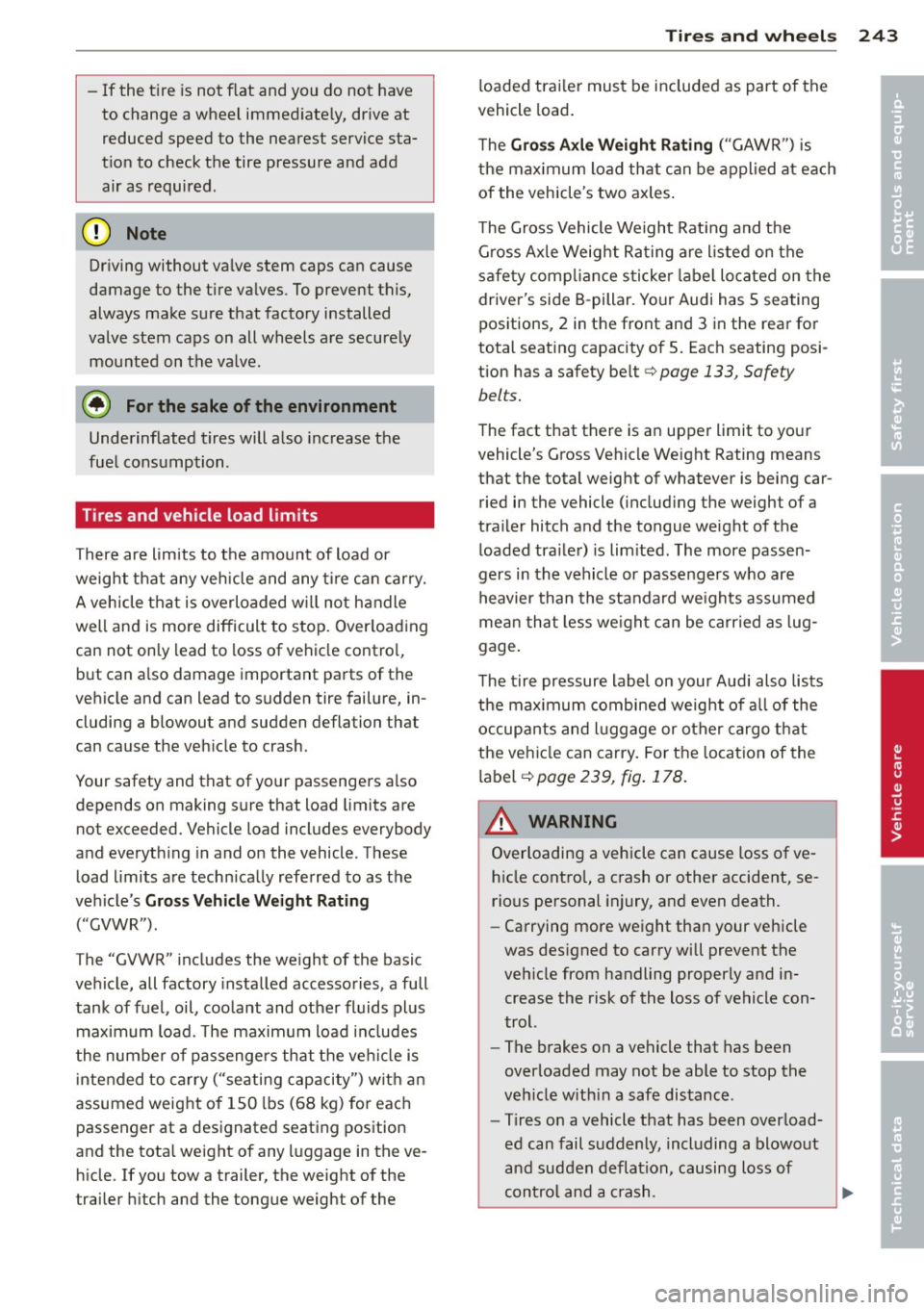
-If the ti re is not flat and y ou do not have
to change a wheel immed iate ly, drive at
reduced speed to the nearest service sta
t ion to check the tire pressure and add
air as required.
(D Note
Dr iving without va lve stem caps can cause
damage to the t ire va lves . To prevent this,
always make sure that factory installed
valve stem caps on all wheels are secu re ly
mounted on the va lve .
@) For the sake of the environment
Underinflated tires will a lso increase the
fue l consumption.
Tires and vehicle load limits
There are limits to the amount of load or
weight t hat any veh icle and any t ire ca n car ry.
A vehicle that is overloaded w ill not handle
well and is more difficult to stop. Overload ing
can not on ly lead to loss of vehicle contro l,
but can a lso damage important parts of the
vehicle and can lead to sudden tire failure, in
cluding a blowout and sudden deflation that
can cause the ve hicle to crash.
Your safety and that of yo ur passenge rs a lso
depends on making sure th at load limits are
no t exceeded. Vehicle load includes everybody
and everyth ing in and on the vehicle. These
load limits a re tech nica lly referred to as the
ve hicle's
Gross Veh icle Weight Rating
("GVWR").
The "GVWR" includes the we ight of the basic
ve hicle, all factory installed accessories, a full
tank of f uel, oil, coo lant and othe r fluids plus
max imum load. The maximum load includes
the number o f passenger s that the ve hicl e is
intended to carry ("se ating capacity") w it h an
assumed weig ht o f 150 lbs (68 kg) for each
passenger at a designated seating position
and the tota l weight of any luggage in the ve
h icle. If you tow a trailer, the weight of the
trailer hitch and the tong ue weight of the
Tire s an d wheel s 243
loaded tra ile r must be included as part of the
vehicle load .
T he
Gro ss Ax le Weight Rating (" GAWR") is
the max imum load th at can be applied at each
of the vehicle's two axles .
T he Gross Vehicle Weight Rat ing and t he
G ross Ax le Weig ht Ra ting are l iste d on the
s af ety comp liance s tic ke r la bel lo cated on the
driver's side 8 -pillar . Yo ur Audi has 5 sea ting
positions,
2 in the front and 3 in the rear fo r
total seating capacity of
5. Eac h seating posi
tion has a safety be lt
c> page 133 , Safety
belts.
The fact that there is an upper limit to yo ur
vehicle's Gross Vehicle We ight Rating means
that the total weig ht of whatever is being car
ried in the vehicle (includ ing the weight of a
tra ile r hitch a nd the tongue weight of the
loaded tra ile r) is lim ited . The more passen
gers in the vehicle or passengers w ho are
heavier than the sta ndard we ights assumed
me an t hat less we igh t ca n be ca rried as lug
gage.
T he tire pr essure label on your Audi also lis ts
t h e maximum combined weight of a ll of the
occupants and l uggage or other cargo that
t h e ve hicl e can carry. For the locat ion of the
label
c> page 239, fig . 178.
.&_ WARNING
-=
Overloading a vehicle can cause loss of ve-
h icle cont ro l, a c rash or other accident, se
rious pe rsonal injury, and even death.
- Ca rrying more we ight tha n your veh icle
was des igned to carry wi ll prevent the
veh icle from handling properly and in
crease the risk of the loss of vehicle con
trol.
- The brakes on a vehicle that has been
overloaded may not be able to stop the
ve hicle w it hi n a safe distance .
- Tires o n a vehicle that has been over load
ed can fail suddenly, including a blowout
a nd sud den defla tion , causing loss of
cont rol and a crash .
li1'-
•
•